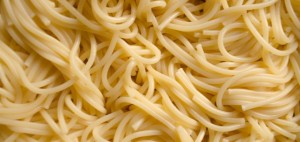Spaghetti and Jewish Unity

Last week afforded me an opportunity to sit with a group of Jews spanning the gamut of American Jewry – resolute secularists, members of non-Orthodox congregations and Orthodox Jews – to discuss Jewish unity and how it can be strengthened.
Most American Jews, rightly or not, don’t think they are capable of living observant Jewish lives. With the passage of time, the Holocaust has lost the binding power it once had for many Jews; and Israel, unfortunately, has become a source of contention rather than unity for many American Jews, particularly younger ones. It’s unfortunate, but unfortunately true.
Someone in the group raised the fact that the coming Shabbos – the Shabbos past, as you read this – was to serve as a Jewish unifier, through the “Shabbos Project,” the brainchild of South Africa’s chief rabbi, Rabbi Dr. Warren Goldstein that has brought together thousands of Jews in observance and celebration of Shabbos over the past two years. More than 550 cities in 70 countries were set to participate in this year’s event.
What other means, though, could bring Jews together? Many aspects of Torah-centered life involve things that, sadly, do not resonate with – or, worse, sadly, even offend – some American Jews, infected as they are with misguided notions like “egalitarianism.” And even Shabbos, in the end, observed properly, involves trials that might challenge many a Jew who was not raised observant – a fact to which anyone who has been stuck in an erev Shabbos traffic jam near shkiah can readily attest.
I suggested the study of Torah, which, after all, is the very genesis of Jewish unity, that which was bequeathed us all at the foot of Sinai, when we stood “as one person, with one heart.” And the proposition that Torah-study remains a potent unifier of Jews is well borne out by the experience of programs like Partners in Torah and TorahMates. (The brachah we make each morning, it’s worth noting, is “Nosein haTorah” – pointedly in the present, not the past, tense. The Torah is still being given to Klal Yisrael.) The idea was well received.
Afterward, though, I thought of another mitzvah that should present no problem to any Jew, and that can serve as a unifying observance.
The two d’Oraysa brachos – birkas haTorah and birkas hamazon – and the many other brachos we make regularly on foods or mitzvos, or as birchos hoda’ah – comprise a paramount element of Yiddishkeit. They focus our attention on the Source of our blessings, and can serve as a potent unifying force for all Jews.
By undertaking to recite brachos, an otherwise distant Jew can be reminded that he or she is connected to the rest of Klal Yisrael multiple times a day, every morning, every time a flower is sniffed, thunder is heard or one is sitting down to a plate of spaghetti.
What a powerful campaign a broad-based “Brachos Project” could be. No non-Orthodox Jew could have a problem with it – brachos, after all, are egalitarian. There are many excellent guides to brachos in English, and reciting them entails no expense or inconvenience.
Truth be told, such a project could also do us some good, too. As we are reminded by the baalei mussar, reverence can all too easily devolve into rote, and that is particularly true when it comes to brachos. Many of us find ourselves reciting them by habit, without pronouncing their words distinctly, much less focusing on their meaning. Anyone who’s watched a baal teshuvah recite a brachah has been graced with a good example to follow.
Rav Chaim Vital testifies that the Arizal called birchos hanehenin “the essential way for a human being to attain the spirit of holiness… removing the [unholy] shells and [sublimating] his physicality,” adding that the Arizal “admonished me greatly about this…” (Etz Hachaim, Shaar Ruach Hakodesh).
The mystical perspective alluded to by those words is that the human being straddles the realms of the physical and the spiritual. Food mediates between the two, nourishing the bodies that house our souls. So it should not be surprising that the act of consuming food would provide opportunity for bringing the holy into the mundane, for removing the “shells” and rarifying physicality.
What better empowerment of Jewish unity could there be than a rededication of Jews from all types of communities and walks of life to sharing in an observance that reflects the quintessential Jewish ideal of acknowledging Hashem’s blessings? And, at the same time, strengthening our own dedication to brachos?
Who knows what other shells might thereby be removed?
© 2015 Hamodia



Recent Comments